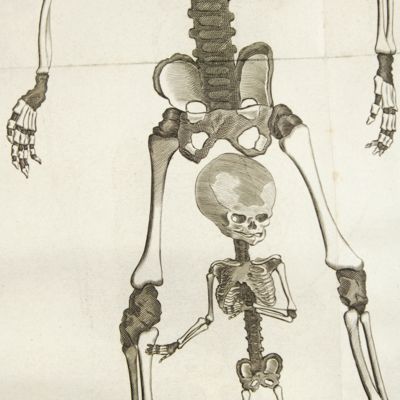Kerckring, T.
Opera omnia anatomica; continentia spicilegium anatomicum, osteogeniam foetuum: nec non anthropogeniae ichnographiam. Accuratissimus figuris aeri incisis illustrata. Editio tertia.
Lugduni Batavorum [Leiden], Theodorus Haak and Samuel Luchtmans, 1729. Three works in one. 4to (23.2 x 18.3 cm). Frontispiece engraving by A. Blotelingh; title page with woodcut vignette "Tuta sub Aegide Pallas", xx, 303 pp., including titles to the Osteogenia foetuum, in qua quis cuique ossiculo singulis accedat mesibus, quidve decedat, & in eo per varia immutetur tempora, accuratissimè oculis subjicitur (with copper engraved vignette "Structa super lapidem qui ruet ista domus" and blank verso) and Anthropogeniae ichnographia sive conformatio foetus ab ovo usque sad ossificationis principia, in supplementum osteogeniae foetuum (with wood-engraved vignette); 40 engraved plates (several large, folding); Marbled limp paper boards, green label with script title on the spine.
A major work on the development of bones in human fetusses. Theodor, or Dirk Kerckring (also Kerckeringh or Kerckerinck) (1638-1693) was a Dutch anatomist and chemical physician. According to Morton (Garrison-Morton, 4th ed.), his full name was Thomas Theodor, and he was born in 1640. "Kerckring is remembered for his Spicilegium anatomicum, which is an anatomical atlas of clinical observations, medical curiosities [e.g., polydactyly], autopsy discoveries along with general anatomical information. He is credited with describing 'Kerckring's ossicles', which is an occasional ossification centre in the occipital bone that appears around the 16th week of gestation. He also provided a comprehensive description of the folds of the mucous membrane of the small intestine. These anatomical folds go by several different names, including the 'valves of Kerckring', 'Kerckring's folds', plicae circulares and valvulae conniventes. Kerckring used a microscope made by Spinoza." (Wikipedia). This third edition combines works previously published separately, as is shown by the two additional titles which are integral parts of the work but give as place, publisher and publication year "Lugduni Batavorum, Corn. Boutesteyn, 1717". Most "plates" are small to large (several page-sized) text engravings. The numbering is not coherent at all and quite confusing, it is as follows: I, II (a "true" plate, very large, double-folded), III, 4, XXVII, VI, [p. 46 (no number)], VIII-XXVI, XXVII (the same as between 4 and VI), XXVIII, XIX (a "true" plate, large, double-folded), XXX (do.), XXXI (do.); in the second paper it continues as; XXXII-XXXIV, XXXV (a "true", folded plate), XXXVI (do., larger, double-folded), XXXVII (do.), XXXVIII (do.), XXXIX (do.), [p. 301 (no number)]. Apparently plate XXVII also serves as plate V. Boards rubbed and abraded near the edges, corners frayed. Text pages and plates - except for some very occasional, mostly marginal spotting - clean, with bright impressions. Rare. Garrison-Morton, 383.




